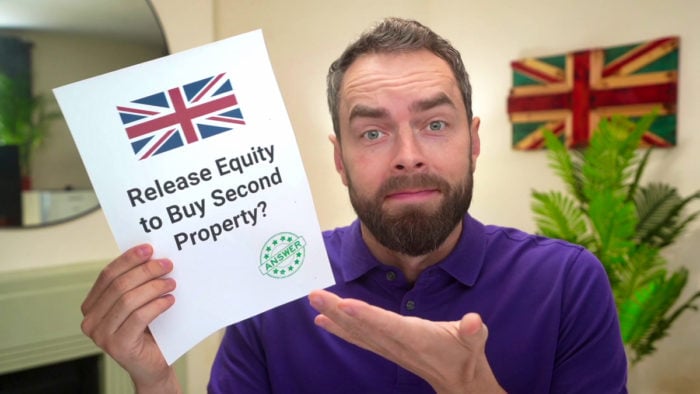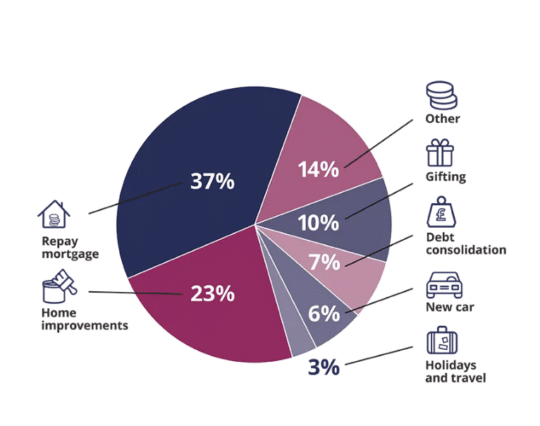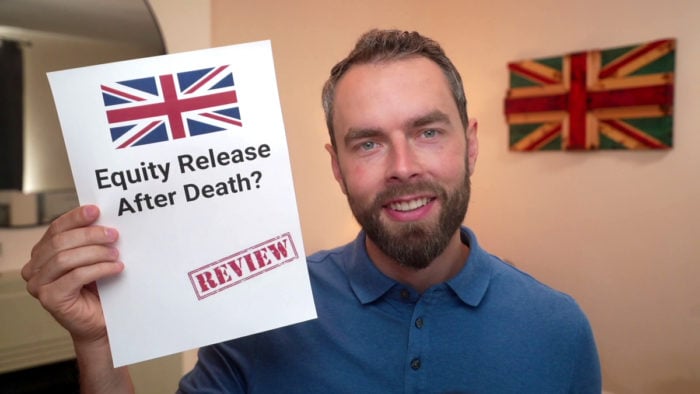Release Equity to Buy Second Property – Is It a Good Idea?
Our preferred equity release adviser is Age Partnership. For free and impartial money advice you can visit MoneyHelper.

Our preferred equity release adviser is Age Partnership. For free and impartial money advice you can visit MoneyHelper.
Are you trying to find out how much equity you can release from your home to buy another? You’re in the right place. Each month, over 7,000 people visit our website for advice on equity release. In this article, we’ll cover:
- How to release equity from your home to buy a second one.
- What equity release schemes are and how they work.
- The good things and the not-so-good things about equity release plans.
- How to get a fair quote for equity release.
Studies found that over half of equity release customers use equity release to fund home improvement projects1, demonstrating the versatility of this financial option. For those looking to release equity specifically to purchase another house, our guide is tailored to walk you through the process.
We know that releasing equity from your home is a big decision, which is why we want to give you all the information you need to make the best choice.
Let’s walk you through your options.
Buying a second home?
Is it a good idea to release equity to buy a second home? And can you release equity to buy a second property? If so, how can you do it? I discuss the different methods of releasing equity to buy another property, including equity release for seniors and the possibility to use a second charge or remortgage to buy another property as a younger homeowner.
Due to their age, income, credit history and affordability, many older purchasers struggle to secure a suitable mortgage or, worse yet, are completely shut out of the mortgage market.
It is especially wise to release equity in order to purchase a property when the value of the second property is less than the equity that is being released.
Can you take out equity to get it?
It is possible to release equity to buy a second property, such as a holiday home, investment property or rental investment.
Home equity is the value of your home that you own outright, calculated by subtracting any debt attached to your property away from the current property value. The equity released is tax-free, paid as a lump sum, and yours to spend as you wish.
For example, you might own a £200,000 home with an outstanding £100,000 mortgage. This means you have £100,000 home equity (50%). You can use some – not all! – of this equity to help buy another property outright or with another mortgage.
There are multiple ways of releasing equity from your house to buy another property, depending on your age and finances.
How equity release could help
More than 2 million people have used Age Partnership to release equity since 2004.
How your money is up to you, but here’s what their customers do…
Find out how much equity you could release by clicking the button below.
In partnership with Age Partnership.
How do I do it?
The method you use to release equity to buy a second property will depend on the options available to you, which are based on personal circumstances.
The most exclusive method of releasing equity to buy a second property is reserved for senior homeowners who already own their home with no existing mortgage. These are called equity release schemes.
Homeowners who aren’t seniors can instead remortgage to buy another property, or they may use a second charge mortgage to access some of their home equity and help buy another property. Both of these methods may require the homeowner(s) to get an additional mortgage to help fund the rest of the purchase, such as a buy-to-let mortgage if they are looking for a rental investment.
Only consider equity release products or services from a company that is authorised and regulated by the Financial Conduct Authority (FCA).
» TAKE ACTION NOW: Fill out the short debt form
How does it work?
Equity release schemes allow the homeowner to use the money for any purpose. So, technically they could use it to buy a second home, especially when it’s difficult for seniors to get another (buy to let) mortgage – but there can be somewhat of a complication.
The homeowner can be forced to sell their original home and pay back the debt if it is found that they are no longer living at the property. So any purchase of a second home must be as a rental investment or as a holiday home only rather than a new home to live in.
Each lender may have different criteria on what constitutes a holiday home and how much time is spent at the property. The maximum amount of time you’ll be allowed to spend in any holiday home will be a few months within a calendar year. You should discuss this with your financial adviser, especially if you plan to downsize to the holiday home in the future.
There may also be tax implications when using released equity to purchase a second home. This is something else you should speak to your financial adviser about.
There are two ways to release equity and buy a second home in the UK. They are lifetime mortgages and home reversion plans. I explain each of these below.
» TAKE ACTION NOW: Fill out the short debt form
Lifetime mortgage
A lifetime mortgage allows up to 60% equity release on the full value of the existing property as there will be no existing first charge mortgage. This money is subject to a fixed interest rate for the entirety of the deal. The interest, alike the capital loan amount, does not need to be repaid each month and is only repaid when the property is sold.
However, even a standard interest can more than double the debt over a decade. Some people choose to make voluntary interest repayments to stop their debt from growing.
I’ve highlighted the significant interest rates associated with equity release before. The more you borrow, the higher these rates become. This can limit the benefits you get from the equity release.
Home reversion scheme
A home reversion plan does not charge interest on the amount of equity taken out. But there’s more involved when it comes to understanding home reversion. It requires the homeowner to give up a larger portion of the property’s eventual sale proceeds, usually more than double. For example, you may take out £40,000 (20%) equity on a £200,000 property and then have to pay back 50% of the sale value (£100,000+)
A Comparison
Here’s a table that will help you better understand the main differences between a home reversion scheme and a lifetime mortgage. If you want to learn more about equity release, be sure to read our complete guide.
| Category | Home Reversion Plan | Lifetime Mortgage |
|---|---|---|
| Ownership of the Property | You will sell either a portion of or the whole value of the home and then be allowed to stay on the property as a tenant. The lender will become a co-owner. | When you take out the secured loan against the property, it will remain in your ownership until you pass/move into long-term care. |
| Change in Value of the Property | With a co-ownership, you will be directly impacted by the property’s value in current markets. This means that you could just as easily lose out on money in the case of a value decrease as you could benefit from an increase. | Since this loan is typically paid off by the sale of the property after passing/owner is moved into long-term care, the value of the home after this case may impact how much money will be left to the estate/family once it has been sold. |
| Inheritance | While some plans do offer a guaranteed inheritance amount, it is likely that the inheritance will be dramatically reduced because you’ve sold a large portion of the property. | Some lifetime mortgages allow for an inheritance protection scheme, but the overall inheritance amount is decided by the loan size and accrued interest. |
| Repayment | No repayment required during your lifetime. It will be paid back once the property is sold. | Some lifetime mortgages allow for partial, voluntary repayments during your lifetime. However, the majority of the loan will be paid back once the property is sold. |
| Type of Payment | There is a choice between a lump sum payment or a regular income with this loan. You can also choose a mixture of the two. | You can either receive a lump sum loan, or you can choose a drawdown facility which allows you to take out money whenever you need it. |
Can I remortgage my home to get another property?
Younger people do not have access to equity release schemes, but they can still use some of the equity they have built up to help buy a second property. They’ll probably need to use the money and another mortgage to complete another property sale, but it all depends on individual circumstances.
Remortgaging is when you swap your existing mortgage for another one with a better interest rate. But when you remortgage to buy another home, you simultaneously ask to borrow more using your home equity as collateral.
How much equity do you have?
It’s actually fairly simple to work out!
For example, if you have a £200,000 home with £100,000 mortgage and £100,000 home equity, you ask the new mortgage provider to lend you £100,000 to pay off your old mortgage, and some additional money that can be used to help purchase a second property.
So, you may ask for a £150,000 mortgage and use the extra £50,000 to help buy a rental flat or holiday home.
If this is something you are considering, make sure you speak to your mortgage adviser beforehand.
Using a second-charge mortgage
Another option is to use second-charge mortgages, also known as a home equity loan or home equity line of credit (HELOC). These are additional loans taken out on a property and secured with home equity. So you keep your existing mortgage and just apply a second debt to the property.
By not swapping your outstanding mortgage to another provider, you may avoid some costly early repayment fees to boot.
Returning to our previous example, you have £100,000 equity in your home and a £100,000 mortgage. The mortgage remains the same but you ask a lender to let you borrow £50,000 against your home equity as a secondary debt on the property.
Repayments will be separate from your mortgage repayments. The amount you can borrow against your equity will depend on your finances and the lender’s loan-to-value ratio.
What are equity release schemes?
Equity release schemes are available to senior homeowners on their main residence when they own their home outright and it is valued above £75,000. They must meet a minimum age requirement to qualify, usually between 55 and 65 years old.
An equity release scheme allows the homeowner to access some of their home equity and never have to make any monthly repayments. The debt is paid back in another unique way. If the homeowner moves into long-term care, they must sell their home to repay the debt.
If they never move into residential care, they only repay the debt from the sale of the property after death from their estate. For as long as they are living on the property, they do not need to make any repayments.
Looking into the types of equity release schemes with a financial adviser will help you uncover your equity release options.

